This is a Veteran Owned site

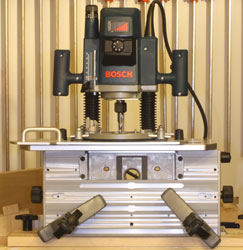 |
The Leigh FMT Jig is obviously well made and thoughtfully engineered. It is also far easier to use than I would have thought! Click image to enlarge |
Leigh Frame Mortise and Tenon Jig
Mortise and tenon trickery the Leigh (easy) way
Text, photos and video by Tom Hintz
Posted - 7-16-2009
The big-thinking folks at Leigh Jigs just couldn't stop at making the best, most accurate dovetail jigs money can buy. The Leigh FMT (Frame Mortise and Tenon) Jig is what we get when they apply their world-class innovation and manufacturing horsepower to the super strong and very traditional mortise and tenon joint. Naturally, the Leigh FMT Jig is loaded with features that make it easy to create single, double, triple and quadruple (in many arrangements) mortises and tenons, including angled and compound angled versions of all of the above. Naturally, the jig itself is first rate throughout in both materials and manufacturing. Quality was the first tradition Leigh developed and they appear to be in no danger of giving up on that concept.
The Basics
The Leigh FMT Jig is built around high quality aluminum components that are CNC (computer numerically controlled) machined in all critical areas to insure accuracy, which makes setup and joint-fitting adjustments easy and predictable. Many commonly used features are tool free to make using the Leigh FMT Jig simple and fast. Specialty drivers are included where the Leigh FMT Jig needs them.
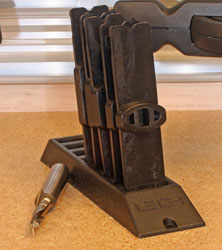 |
Leigh includes one of their high-quality 5/16" bits and a set of guide plates to get you started. these parts actually create a bunch of joint sizes. Click image to enlarge |
The basic Leigh FMT Jig kit includes the jig itself along with the very trick router mounting system that accommodates nearly all popular plunge routers (plunge router is necessary) and includes the necessary mounting screws and brackets. They also include centering tools that make aligning the router perfectly virtually foolproof. And, this mounting system makes it easy (and very quick) to remove the router for other uses in the shop. When re-installed on the Leigh FMT Jig the specially designed mounting pieces make sure that it is once again perfectly aligned.
Leigh also includes one of their 5/16" HSS spiral upcut bits (1/2" shank, Leigh No. 170-500) and five 5/16" joint guides (5/16" by 1/2", 3/4", 1", 1-1/4" and 1-1/2"), which can make over 21 sizes of mortises and tenons. You can get additional joint guides and bits for 1/4", 3/8" and 1/2"-wide tenons. That gives the Leigh FMT Jig an overall capability of over 70 mortise and tenon sizes up to 1/2"-wide x 5"-long. Plus, Leigh provides information on procedures to make much longer mortise and tenons.
Jig Body
The Leigh FMT Jig is built around a heavy-duty aluminum body that is precisely machined to insure accuracy and ease of use. The front of the body has a hinged plate on which the very trick Leigh cam-action speed clamps are mounted for securing a huge range of stock sizes. This plate can be angled up to 30-degrees
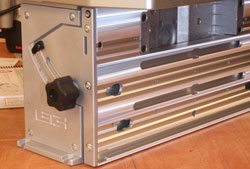 |
 |
The all-aluminum jig body (left) is precision machined to insure accuracy and ease of use. The end caps on the body (right) have recesses for the included nuts and bolts for attaching the FMT to a board that makes it much faster to get it out and clamp it to a work surface. Click images to enlarge |
|
outward from vertical plus the stock can be angled on the plate. With these adjustments available, cutting ultra-precise mortise and tenons with single or compound angles is easy and repeatable.
Leigh includes an adjustable side stop fence that operates in grooves in the front plate. This fence can be indexed straight up and down or reversed for use at an angle using your protractor for accuracy. It clamps in place securely by turning a hand-operated knob.
The end caps of the Leigh FMT Jig body have cast-in recesses for included nuts and bolts for attaching it to a board. Mounting the jig to a board makes it quick and easy to bring the Leigh FMT Jig out and clamp it to a bench or other surface for use.
Dust Collection
 |
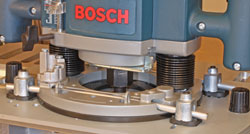 |
The Leigh FMT Jig has built-in dust collection (left) and comes with adapters for popular hose sizes. The trick router mounting system (right) makes it easy to mount and then use the router for other purposes without losing accuracy. Click images to enlarge |
|
The Leigh FMT Jig body also has a dust collection port built into the rear. It has a 1-3/8" port but includes adapters that accommodate hose sizes it up to 2-1/2" or down to 1". The dust port is centered on the rear of the Leigh FMT Jig body so the hose is completely out of the way while you are routing mortises and tenons. Because of the dust collection cavity shape it is surprisingly effective and keeps the work area much cleaner than I expected.
Router Sub-Base
A lot of the really fancy stuff happens around the Sub-Plate atop the Leigh FMT Jig. This plate has provisions for mounting just about any plunge router and Leigh includes the necessary hardware for nearly all of them. In addition to simple screws for some routers, Leigh developed an ingenious set of bars and u-shaped mounts that accommodates the big majority of plunge routers. After the initial setup, this bar mount system lets you remove the router for other shop duties. Those same mounts allow remounting that router to the Leigh FMT Jig so that it is perfectly aligned and do it in a minute or two.
 |
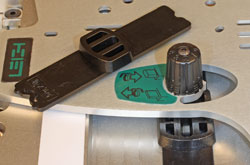 |
The included alignment mandrels (left) make getting your router perfectly centered a no-brainer. The adjustable pins (right) follow the precision guides and make "tweaking" the joint fit to how you like it very simple and repeatable. Click images to enlarge |
|
Getting a router aligned with the jig perfectly would itself be a major pain if it were not for a pair of alignment "mandrels" included with the Leigh FMT Jig. These composite mandrels have a major diameter that matches the center hole in the Router Sub-Base. The other ends of the two mandrels that are included have a stepped 1/4"- 1/2" and 8mm-12mm shank. Put the right alignment mandrel in your router, put the big end in the hole in the Router Sub-Base and you literally assemble the rest of the mount around it. If you don't get it perfect, you simply are not trying - or paying attention.
Even with the weight of the installed router the Sub-Base nearly floats on a set of super low-friction strips. The ease with which the Sub-Base moves along with the built-in handle on the left side makes following the guide plates very easy and predictable.
The Sub-Base has pair of pins on the underside that engage guides that essentially force you to cut perfect joints. Each of the pins is tapered and can be adjusted by turning the knob on the top side of the Sub-Base. The knobs have numbers around the tops to help you quantify (and record) the amount of change. Each 1/8-turn of the guide pin knob results in a 0.001" change on each side of the tenon! This adjustment lets you "dial in" mortise and tenon joints that fit exactly as you like them to. Smart woodworkers will record these settings to repeat specific joint fit later.
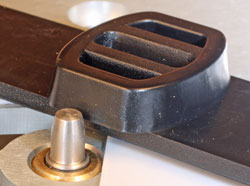 |
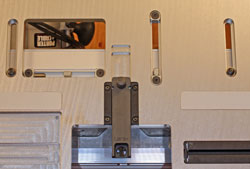 |
The combination of the highly-precise adjustable pins (left) along with the alignment reticule and adjustable limiters (right) make setting the Leigh FMT Jig up for a huge range of mortise and tenon joint types surprisingly easy and accurate. Click images to enlarge |
|
The top of the Sub-Base has a recess on the left side that accepts the guide plates that those pins follow to create the mortise and tenons. A permanent single-slot guide on the right side keeps that pin tracking correctly. Leigh supplies a set of guide plates for 5/16" mortise and tenons but other sets are available for accessories and they fit into the same recess. A spring-loaded latch secures the guide plates and makes changing them fast and tool-free.
Leigh added a slide-out reticule "sight" that makes aligning the Leigh FMT Jig with the desired joint position on the wood very easy and exceptionally accurate. Clamp the wood in place with the centerlines drawn where you want the joint and adjust the table so that the reticule is centered on those lines. The entire jig table moves front-to-back and side-to-side so you can set it wherever is needed. The table is locked in place with a singe lever on the side. There are also fully adjustable stops built into the table that control front-to-back and side-to-side motion for repeating joints or making multiple mortise and tenon joints.
The top of the jig body has front-to-back and side-to-side limiters that make it easy to set up for multiple mortise and tenon joints as well as oversized joints of your own design. Lay out the multiple mortise and tenon and use the slide out reticule to set the appropriate stops and it is almost difficult to make a mistake.
Leigh includes two outrigger bars and instructions for making removable wings for cutting multiple and oversized joints. These simple pieces substantially increase the capacity of the Leigh FMT Jig while enhancing accuracy and speed.
User Manual
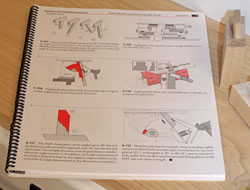 |
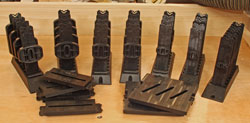 |
The user manual (left) that comes with the Leigh FMT Jig continues their tradition of producing the finest instructions anywhere. Leigh does not spare the budget on their manuals and the user benefits every time they use one of their products. Leigh offers a large range of guide template sets (right) and bits (bit sets also available) that enable the FMT to make a huge range of joint sizes and joint types! Click images to enlarge |
|
Leigh has always written and printed the best instruction manuals in woodworking and any other field that I am aware of. The manual that comes with the Leigh FMT Jig is no different. It does feature larger page sizes than the D4R dovetail jig manual but retains all of the high-end illustrations, extremely clear writing and the expensive spiral binding. That binding allows the manual to lay flat without you having to weigh down the pages. The information in this manual, along with the design of the jig itself make using Leigh FMT Jig much easier than I anticipated.
Leigh also maintains a special section of their website where they post updates to their user manuals. That section also contains special instructions for even more operations the Leigh FMT Jig is capable of. All of this information is free and available 24 hours per day - including the weird hours when woodworkers tend to get stuck....
In the Shop
Note: Throughout this evaluation I used my Bosch 1613 AEVS Plunge Router on the Leigh FMT Jig. The combination of the Bosch 2.25HP and the high-quality Leigh bits meant there never was a hesitation in cutting mortises or tenons. This is a very good router for the Leigh FMT Jig.
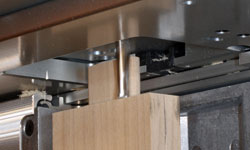 |
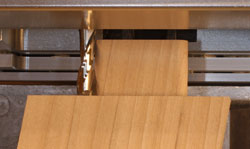 |
Actually cutting straight (left) or angled (right) tenons is simple. Use the procedures described in the User Manual and the results are very clean and very accurate. the adjustability of the joint fit is remarkable. Click images to enlarge |
|
The first thing that impressed me about the Leigh FMT Jig is how easy it was to set up. Part of that is due to the surprisingly little amount of assembly needed in the first place. The rest is because the Leigh FMT Jig is so well made and thought out.
Leigh also makes the critical operations of installing/aligning the router a virtual no-brainer thanks to the included alignment mandrels and very clear instructions. If you get the alignment wrong, you have to be trying to mess it up or you did not read the instructions - or both. Many will also like how the router can be removed for other shop chores and quickly re-installed on the Leigh FMT Jig without losing the accuracy. Very nice touch for those of us who lack the unlimited router budget.
Using the Leigh FMT Jig is also much easier than I anticipated. With very little experience the most difficult part of making joints on the Leigh FMT Jig is marking their positions on the wood. Get that right and the rest is simple, fast and very accurate. The Leigh FMT Jig process is so easy that I found myself "waiting for the other shoe to drop", so to speak. I cut a very nice looking mortise and tenon the first time around but it was a little too tight, I dialed in a correction (1/2-turn up on the left side pin) and the fit was perfect. It really is that simple - and there is no other shoe that is going to drop.
I also had some reservations about making the initial clockwise cut that insures a very clean shoulder on the tenons. Yes, this is a climb cut but if you pay attention the control provided by the router and Sub-Base plate make this surprisingly easy.
It also did not take long for me to appreciate the design and quality of the Leigh bits. They make plunge cuts like a high-quality drill bit yet route out the mortise and cut tenons cleanly with little effort. The evaluation of the Leigh FMT Jig went far longer than I anticipated because of other distractions in the shop so I wound up cutting far more joints than anticipated. The Leigh bits cut the last joint just as cleanly and easily as the first one.
Video Tour! |
Cutting angled or compound angle mortise and tenons is almost as easy. Again, marking the piece and aligning that with the crosshair reticule is the toughest part. Follow the instructions and the Leigh FMT Jig cuts the joint perfectly. And the dial adjusters remain as effective for fine-tuning those types of joints. Where woodworkers used to try avoiding angled mortise and tenon joints, the Leigh FMT Jig could have you seeking out those kinds of projects just to show off. Building chairs with their typically angled sides is nearly a no-brainer with the Leigh FMT Jig.
Because of how the Leigh FMT Jig cuts joints, getting the flat surfaces of the joined pieces of the same thickness to align is very easy. The manual tells you to mark one face of the pieces to be cut and to put that mark against the Leigh FMT Jig when the cuts are made. That allows cutting the joint without making any further adjustments. For joining a thinner piece to a thicker one, use the alignment reticule to center the mortise in the thicker stock. It really is that simple.
Making the mortise and tenon joint is not the only trick that the Leigh FMT Jig is capable of either. This jig can do dowel joints, bridle joints (multiple and angled bridles also) and more. Guide plates are even available for cutting perfect louver slots, square tenons and for cutting mortises 90-degrees to the grain for special applications. The instruction manual covers a huge range of situations but Leigh also supports the Leigh FMT Jig with an ever-growing list of technical bulletins available for free that walk you through special techniques and uses of the Leigh FMT Jig. In addition to all that and I suspect there are shop-specific capabilities woodworkers will discover once they start using the Leigh FMT Jig.
Conclusions
The Leigh FMT Jig is a very well made jig as previous Leigh jig users would expect. The ease of use, adjustability and accuracy are also typical Leigh but are easier to attain than expected of a jig with such far-reaching capabilities. They really do have the Leigh FMT Jig figured out as well as how to make it easy to use. Once again Leigh has produced a top shelf user manual that explains and guides the woodworker through the process with ease.
If you enjoy using the mortise and tenon joint, or WANT to enjoy making them, the Leigh FMT Jig is for you. If you appreciate well made tools and quality engineering the field of contenders is limited to the Leigh FMT Jig. With a street price of $699.00 (7-10-2009) the Leigh FMT Jig is an investment that will serve you for many years to come.
Visit the Leigh Jigs web site - Click Here
See my Rolling Jig Work Station Plan! - Click Here!
Have a comment on this review? - Email Me!
All written, photographic and drawn materials are property of and copyright by NewWoodworker.com LLC 2000-2019. Materials may not be used in any way without the written permission of the owner.

